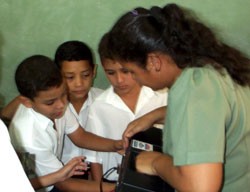
Challenge
Nicaraguans receive an average of only 4.6 years of schooling in their lives, and just 2.1 if they live in poor, rural areas. Nearly 500,000 children between 3 and 12 are receiving no schooling whatsoever. Increasing access to quality, primary education for all children is vital to Nicaragua’s social and economic development.
Initiative
USAID is supporting a long-term effort to improve the quality of primary education by improving teaching skills and rallying community support for schools. USAID has trained 20,000 primary school teachers and administrators in modern teaching methods and is integrating reforms into “model schools.” With an emphasis on rural education, bilingual education, parent and community involvement and educational research, USAID’s educational reforms encourage innovative education with instruction designed to accommodate each student’s style and learning pace. Active student and parent participation are hallmarks of the model school approach. USAID has set up model schools in every municipality in the country to improve access to primary education, reduce the drop-out rate and increase the number of students that complete the sixth grade.
Results
The testimony of teachers, parents and students is evidence that the program is working. Community participation in support of school quality became a distinguishing feature of the reforms — in 2003, 96 percent of urban parents and 93 percent of rural parents participated in model school activities. Today, 20 percent more students complete their education in model schools than do in non-model schools, and academic achievement in model schools has risen 8 percent in Spanish and 12 percent in math. Due to the success of the model school program, the Nicaraguan government has decided to expand the model nationwide.







Comment
Make a general inquiry or suggest an improvement.